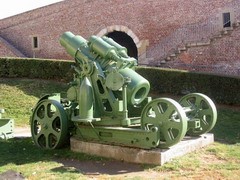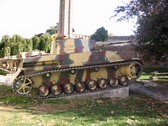Exterior collection
The collection of artillery tools, among other things, formed the basis of the first permanent display of the Military Museum from 1904. Apart from the two cannons that were located in front of the entrance to the Museum building, a large number of pre-loading cannons, including 4 Karađorđ cannons cast in the Serbian foundry in 1811, decorated the exhibition area.
Like most collections, this one was damaged or partially destroyed during the two world wars. After the Second World War, the Museum retained a little more than twenty cannons and howitzers used during the Balkans and the First World War, which the museum received in 1935 from the Kragujevac VTZ, as well as three coastal cannon barrels that were delivered to the Museum from the Kladovo Fortress in 1936. In the post-war years, the collection of objects continued, and a large number of artillery pieces and armored vehicles from the last war arrived at the Museum. Also, from the Adriatic coast, at the end of 1960, about twenty heavy coastal - fortress guns were collected, which are exhibited in the exterior of the Military Museum.
The oldest artillery tools exhibited in the exterior of the Military Museum are priming cannons dating from the second half of the 17th to the 19th century. Except for four pipes, which were cast from bronze-tuch, all the rest are made of iron. The largest number of these pipes were cast in workshops in Austria, a few in France and Great Britain.
Like most collections, this one was damaged or partially destroyed during the two world wars. After the Second World War, the Museum retained a little more than twenty cannons and howitzers used during the Balkans and the First World War, which the museum received in 1935 from the Kragujevac VTZ, as well as three coastal cannon barrels that were delivered to the Museum from the Kladovo Fortress in 1936. In the post-war years, the collection of objects continued, and a large number of artillery pieces and armored vehicles from the last war arrived at the Museum. Also, from the Adriatic coast, at the end of 1960, about twenty heavy coastal - fortress guns were collected, which are exhibited in the exterior of the Military Museum.
The oldest artillery tools exhibited in the exterior of the Military Museum are priming cannons dating from the second half of the 17th to the 19th century. Except for four pipes, which were cast from bronze-tuch, all the rest are made of iron. The largest number of these pipes were cast in workshops in Austria, a few in France and Great Britain.

From the end of the 19th and the beginning of the 20th century, in the exterior of the Museum there are specimens of all the leading European manufacturers of artillery tools of that time (Schneider, Skodawerke, Krupp, Rheinmetall, Societe anonyme des anciens etablissements Cail). In addition to the specimens purchased by Serbia, the exterior exhibits artillery weapons that were confiscated in the First Balkan War, then weapons obtained from the French army during the breakthrough of the Thessaloniki front, several specimens that were found in warehouses after the First World War, and were in the armament of the Austro-Hungarian army. There are also tools that the Kingdom of SHS bought for the needs of the army after the First World War.

After the Second World War, a large number of artillery pieces and armored vehicles arrived at the Museum, including extremely rare specimens. Visitors' attention is particularly attracted by the large number of armored personnel carriers, tankettes and tanks of various countries (Poland, Czechoslovakia, Italy, Germany, Russia, USA). Of these assets, the Polish TK-3 tankette stands out, of which a total of 18 pieces were produced, and the only surviving example is currently exhibited in the exterior. The same is the case with the German light tank PzKpfw I Ausf F VK 1801 of which only 30 were produced and the Yugoslav tank A1 of which only 5 pieces were produced in the Petar Drapšin factory in 1950.
In addition to armored vehicles, the exterior of the Military Museum also exhibits numerous artillery pieces confiscated during the Second World War from the Italian and German occupiers. After almost a century of painstaking collection of tools, one of the, if not the most valuable, then certainly the rarest collections of artillery tools and armor in Europe was created.
The collection is handled by: Nikola Todorović
The collection is handled by: Nikola Todorović
